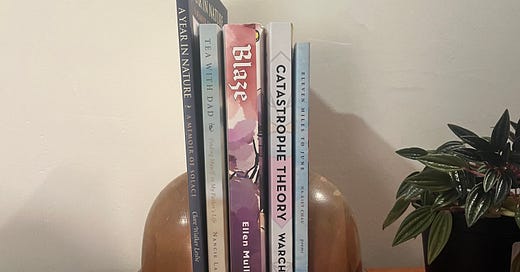Even now that the first frost is here, I am continuing to look back on my artifacts from camp this summer with great love and care. The zines and poems drafted by teenagers dreaming in humid mountains make me happy to be part of the human species timeline. Imagination is not a thing that we’ll ever lose.
The idea of publishing work like that was the reason I first got into the industry, took an unpaid internship straight out of college, and tried to make it work for as long as I could. As the vision of myself as publisher returns to me after some dormant years, I’ve been searching to remember the skills and confidence I have to do this work.
The two books on the right–Eleven Miles to June by Ha Kiet Chau and Catastrophe Theory by Rebecca Lowry Warchut–were manuscripts I pulled from the slush pile to bring to my publisher. My name is sweetly acknowledged in them so they stay upright in my acorn display, but I really had nothing to do with their creation.
The three books on the left were heavily guided by me as an editor and publisher, and taught me many things.
A Year in Nature by Clare Walker Leslie taught me how to use the role as editor to become a critical but delicate observer of art. I didn’t know a lot about editing back then, but I quickly found the things I liked most about Clare’s work to be the things I wanted to propagate in the art I made as an editor–chiefly, multimedia formats and the intimacy of artwork not exactly made for you to see from the start. You can read more about this book and take a peek inside here:
Reading my landlord's diary
I didn’t wake up that day with the task of snooping on schedule, but there are many common spaces at the mill where I live, so personal objects can become public. Within a few minutes and out of hundreds of books on the shelf, I reached for the small, dark-spined journal. Half an hour later, I closed the back cover, not a page skipped.
This knowledge was applied to the first memoir I ever edited, Tea with Dad by Nancie Laird Young, and honed my ability to interact with something someone else had already made and apply my perspective as an outsider to create a more cohesive and shareable story. The collaboration necessary to take a manuscript to the press is immense, and I’m grateful to have had such fulfilling relationships with writers over the years. I’m not sure I’d have such belief in the writer-editor relationship if not for this project—all the shout-outs to you, Nancie!
And then Blaze came along and tested my resolve as a publisher. Produced deep in the trenches of the pandemic, I spent hours on Zoom and phone calls with the printer, the warehouse guys, the ebook team, to give this 400 page YA fantasy any kind of momentum during a time when much of the book world was stifled. But because of this huge obstacle and my commitment to doing everything I could for Ellen, I learned a huge amount about the business of making, storing, and selling books.

Ellen died suddenly less than a year after her book was published. That event brought me back to the idea that publication, especially at the local level, is a dream that I can facilitate for myself and others, and is a dream that means something.
Writing is a huge part of my career and my person, but it’s something I largely want to keep for myself. Writing is what I can take for myself from the world, and publishing is what I can give back.






